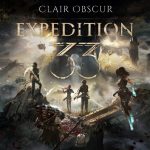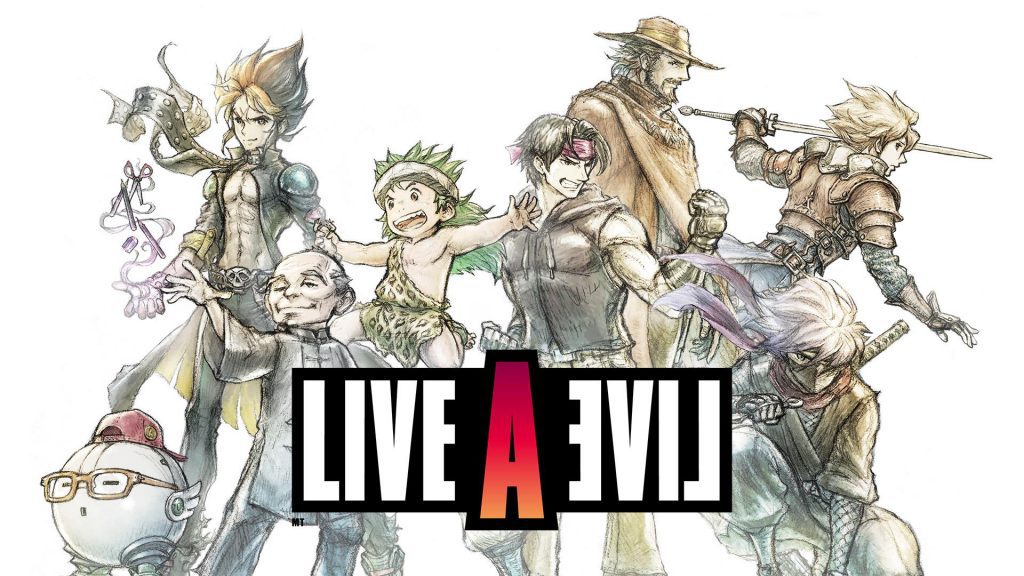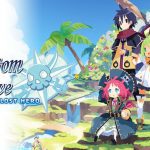As a big fan of SNES RPGs, this is one that I’ve always wanted to try, but never have. There was a translated rom (which is how I got into some of the classics like FF5, Seiken Densetsu 3 and a few others) but still this is one I never ended up checking out for some reason.
I was pretty excited when this was recently announced at a Nintendo Direct, using the HD-2D style.
Well let’s see what I’ve been missing all this time!
Developer: SquareSoft (Original), historia Inc+Squeenix (Remake)
Publisher: SquareSoft (Original), Squeenix+Nintendo (Remake)
Release date: July 22, 2022
Platforms: Switch
Genre: Console-style RPG
Review
There’s 8 stories here, so I’m not really going to go too in-depth with them. The prehistoric story has you trying to save the only living female human from a tribe that wants to sacrifice her to a monster (weird). The imperial china story has you trying to find a successor for your kung fu style. The Edo Japan story has you trying to kill a powerful leader to save Japan from constant war. The Medieval one has you fighting the dark lord as the chosen hero, to save the princess. The Wild West one has you saving a town as a rogue gunman with a bounty on his head. The present is Street Fighter as an RPG-ish game. The near future has you as a psychic boy trying to stop an evil corporation trying to take over the world by kidnapping orphans or whatever they’re doing. And the far future story has you, as a baseball-shaped robot, trying to save a crew on a spaceship. There’s a few things linking each story very vaguely, namely the existence of the Watanabe family (either as side characters, or just mentioned), and they all end with some battle against some corrupt evil enemy that’s a bit on the weird side. At the start of the game 7 of those stories are available for you to play from the start, with the eighth one unlocking when the first 7 are done.
Then the final chapter starts, where you have a few choices to make. First, your main character (who will be stuck in your party). Then it’s just playing to the end of the game, maybe grinding a bit (level 20 is more than enough to beat the final boss), maybe doing some of the side-dungeons to get the best weapons for some of the characters, and finally fighting the final boss. The main characters of each chapter can be found in the area and you can make them join your party, though your party is limited to 4 characters (which character you have on your team does no matter story-wise, so just take the ones you like). There’s 4 possible endings, based on what you do in this final chapter with most characters. And there’s a separate final chapter if you choose a specific one of the 8 characters as your main, with 2 possible endings in that version of the final chapter. So that’s 6 possible endings which is pretty cool, though the 8 first chapters have no influence on that ending, it’s all based on if you do certain things in the final chapter only
One complaint for me story-wise, other than the ending being dependant on only one of the 9 chapters, is that each chapter is pretty… bland. You don’t get a whole lot of time with each character, you don’t get much characterization, and things happen pretty suddenly a lot of the time so development feels very forced. Or there’s something like the Modern chapter which is just fighting a few people and… that’s it, it has no actual plot, just “dude wants to get strong so he fights people”. Then the final chapter… all those characters with their own personalities and shit (even if they’re underdeveloped)? They do and say absolutely nothing, with Sundowner being the only one that seems to be acting like a character until he agrees to join you. It’s not that the game’s story overall is awful, I actually like some of the ideas here, but overall it’s all very under-developed. The best story of the bunch is the prehistoric one, and it doesn’t have dialogue. The rest range from “why was this even a chapter” to “this was okay”.
*EDIT!* I forgot to talk about the localization. It’s not awful for the most part, but since there is japanese voice acting, it’s frequently easy to notice that some of the english wording isn’t accurate to the japanese writing. Some slang and expressions and stuff in place of translating accurately. Just another case of localizers thinking being competent at translating is bad. Just translate the game directly.
One thing I will always be positive about it how good the HD-2D looks here. This does some pretty cool things with it here, from nice sweeping camera shots you wouldn’t have gotten from the original version, and nice big detailed sprites for the enemies. Heck, the graphics in the original are FF4-style very small sprites, while the characters here are way taller, more detailed, and closer in style to Chrono Trigger and FF6. And since this isn’t a straight port (or ROM) of the Super Famicom game, there’s plenty of new stuff here, from some pretty cool FMV cutscenes to actual voice-acting for most lines in the game which really surprised me. I put that shit on Japanese right away. Overall the game looks pretty amazing, sounds pretty good, and some of that music is fucking great. I was actually familiar with the boss theme because of Gametal in his SNES Medley video. It’s some good shit.
So how this game works is that you choose a chapter, go through it, and repeat that 9 times until you’re done with the final boss. Each chapter has its own main character, potential team members and, sometimes, gameplay gimmicks. Some chapters are like proper RPGs, while others have basically no fighting, or even no leveling/equipment at all. Each chapter kind of acts like a tutorial for the rest of the game… which isn’t great since some of the things you get tutorials for are chapter-exclusive, and you really don’t need combat tutorials after you’re done with one chapter. Even though the far future segment isn’t an RPG, it does have a combat tutorial segment, which it needs because, even though there’s only one real battle (against the boss), it still needs a way to teach you the combat, and it does so using an in-game video game. Note that you CAN beat that game (it’s a few battles), but you get nothing for doing so. It does this because, of course, any chapter can be your first chapter. The one that prepares you least is probably the Wild West one, even though it does feature one of the toughest battles in the game if you play the chapter in a specific way.
Each chapter has something of a gimmick to it. Wild West has you preparing for a bandit raid (which is a pretty lame mechanic that’s too easy to do perfectly), the near future has a giant robot, the modern one is just a few battles with a bit of a Street Fighter feel to its presentation, the far future is just… walking to where the game tells you to (except one time where you need to puzzle-solve a bit), the Imperial China has some asshole-y time management (not gonna spoil, but lol), the Edo Japan one has stealth mechanics and a kill counter (and minor potential differences if you try to go for no kills, some kills or all kills), and the prehistoric one has random battles at some point into it as well as a scent mechanic to hunt for food. The Medieval one is the most normal RPG one, with random encounters. And the final chapter has semi-hidden dungeons with some that have unique mechanics. This makes each chapter feel at least a little bit different.
One thing is that there’s no money or shops in any of the chapters, though the prehistoric chapter has a crafting mechanic and the near future chapter has an item-trading mechanic where you can get some good stuff if you know what to give to the item trading NPC. Instead there’s pickups all over the place (plants, treasure chests, lockers, desks, etc.), and enemy drops. No good way to really get useful things like healing items or equipment other than being lucky. Like, most of the equipment you just find in the environment, but there’s some occasional drops. Also robots don’t level up, so you need to find robotic enhancement items to make those stronger (not like that happens much, there’s 2 robot party members in the game, one that doesn’t power up in his own chapter and one that isn’t in the final chapter). There’s also some characters that just don’t level up in some chapters, or there’s no equipment to find to get a bit stronger.
Combat is pretty unique. It’s a grid-based battle system, mixed with fairly normal turn-based combat that looks similar to ATB with the meters (though yes). You start all battles with full HP. Turns are speed-based using a turn meter, though your lead character will always act first. When your turn meter is full, you can move the character in the grid. When you move, this does advance the turn meter of all other units on the field, so enemies might end up getting to attack while you’re moving. When you decide to do something, you have a few options. You can use a skill, which will open your skill menu. You can open the other menu which gives you the option to use an item, Pass your turn (resets your turn meter), Wait (which does the same thing as moving as as far as moving along all other units’ turn meter) and Escape. So mostly you will be using skills.
Skills have a range, which is highlighted on the field. Skills can be attacks, healing, buffs, nerfs, or any random combinations of that (most attacks cause either status effects or stat nerfs, which is pretty surprising). Some attacks hit every space in that range, others allow you to select one target within that range, and others allow you to select a space in that range which will hit adjacent tiles. When you’re hovering a skill it gives you some information: damage (low, medium, high), charge time (low, medium, high), then possible status effect and nerfs caused. Charge time essentially means that the attack will launch at a later point. Kinda like how magic worked in FF6. But if you get hit while charging (or hit an enemy that is charging), you can be interrupted and then have to wait a whole other turn to act again. Of course sleeping, stunning or getting moved to a different space is a guaranteed interruption. Combat is generally pretty good, though you should figure out pretty quickly the best attacks to use for good AOE damage and good nerfs. Items are generally not required to use very often, since you do start battles with full HP. Combat feels a bit clunky at first, but once you get used to attack ranges and movement, it works pretty well.
Powering up is pretty straightforward. In some chapters some characters don’t level up and some do. In the final chapter they all level up normally through getting EXP from battle… except the robot, who still requires a specific item to power up. You can learn new skills up to level 16. You can get new equipment, generally from finding them in the environment, making them in the prehistoric chapter, trading for them in the near future chapter or getting them as random drops from battles… And that’s it as far as leveling, it’s very standard stuff. In the final chapter it’s not really about leveling up but about selecting 4 characters for your final party. As long as you pass level 16 to get all your skills, you’re probably fine. If you’re not feeling safe at a lower level, the bonus dungeons provide the best weapon for each character and plenty of extra grind time. I was level 20 for the final boss and didn’t struggle at all.
I do have a few things in this game I’m not a big fan of though. I will note, while I have a lot of complaints, this is by no means a bad game. It just has a lot of curious design choices overall that, for me, make the experience less interesting.
One complaint is that this game is really easy. I think there’s only like three battles where I actually had the possibility of losing (without, like, playing badly on purpose). There’s one boss I THOUGHT was hard until I realized there was an attack that OHKO’d him. Some chapters have you not leveling up, so they have to make sure the character you’re playing as can win their boss battle easily. Heck, I basically stun-locked the final boss without possibility of even getting hit, and it’s not like I over-levelled, I just happened to have a team that could do that and the boss had no response.
One thing I wonder about is the radar system. It’s another thing that makes the game tremendously easy because, outside of one part in the Far Future chapter and one part in the Middle Ages chapter, the game always tells your exactly where to go (which is a bit questionable since you already get hints from the dialogue). I checked a video of the original game and, yeah, no radar there. The game IS pretty straightforward, so you don’t generally need it, but the radar makes every chapter a no-brainer. Since there’s basically no reason (or, really, any good way) to grind, each chapter is fairly quick too.
Another complaint is the very tiny focus of each chapter. While the prehistoric chapter is a bit bigger than the others as far as areas to travel through, the rest are tiny. Near future is a town, but there’s only 4 areas to visit (2 of which are actually useless) and 3 buildings. The Wild West is just one small village with a few, unimportant buildings, and literally just one battle (or two if you decide to not set up traps, one of which is seemingly one of the tougher battles in the game). The Far Future story has the one spaceship with no fighting (except for a minigame, which serves basically as a battle tutorial if this is your first chapter… beating that minigame gives you no reward). Actually, that chapter is pretty boring because it really is just walking to where the radar wants you to, watching a cutscene, rinse-and-repeat until the end. Not a great chapter gameplay-wise (through the boss is pretty cool). The Imperial China chapter is like 5 single-screen areas and a linear dungeon. The Japan chapter ends up being the most interesting, but it does all take place in one castle. It’s pretty big and labyrinth-like though, I liked that chapter. The most egregious chapter is definitely the middle age one, as it only has very little stuff in it even though it’s meant to be this grand heroic adventure, just a few mostly-useless screens (2 empty towns, a pretty boring mountain, and the path between those) and one dungeon (that you end up going through several times). And the final chapter is just going through a previous chapter again, which is pretty bad for variety. Though it does have some extras optional dungeons which is at least something. It’s not required to do them but it gives you a slight edge for the final boss.
On the positive side, despite the final chapter being a re-thread of a tiny area, there are some secret bosses to find here that might prove to be a bit more of a challenge than the actual final boss of the game. There’s a secret boss that requires you to escape from battles 100 times to fight it, though it might be more advantageous to do all the other secret bosses before dealing with that one. It’s not like you need to do any of this, but it’s cool that it’s there. There’s also 2 secret bosses I missed in the Japan chapter, and a secret boss I missed in the Prehistoric chapter. Those do give good rewards… but, again, it’s not like you need them, since the game is easy. But hey, for the completionists out there, there’s certainly things for you to do.
Overall
I do think it’s unfortunate that this didn’t come out outside of Japan officially until now (some of it was because of how things were at Squaresoft at the time), but at the same time I’d say we weren’t missing much. Not because it’s bad, but more because… I don’t find it to even come close to the other big SNES RPGs. It’s certainly not at the level of FF4/5/6, Mana, Terranigma, SD3, Illusion of Gaia, Chrono Trigger, Lufia 1/2, Mario RPG, Breath of Fire 1/2, Dragon Quest 5, Earthbound… and I could go on (it’s easy to forget how well us Console-style RPG fans ate back in those days). It is a very different kind of game than all these others because it’s trying something very different, but since it is in the genre I think it makes sense to compare them, and it doesn’t compare favorably to a lot of the SNES RPGs.
That said… This was an okay game. It has a weird, small feeling, but a cool experiment (that I feel Octopath Traveler actually improved on). Like, each chapter is just a pretty tiny area to walk around, and the final chapter is just going through the previous chapter again… I was kinda hoping for something more along the lines of… every other SNES RPG, with a world to explore and stuff. This is more concentrated, the storytelling feels a bit like “let’s speedrun character development… oh and the last chapter has no story”, the links between each of the other chapters feels pretty fucking tenuous (minus the consistent inclusion of the Watanabe family). But the combat is fun, and there’s some interesting moments here and there.
I put this more as a mild recommendation. There’s certainly better stuff to get on Switch this year. But it is a much nicer version of the original and, of course, it never came out here so it’s cool to experience this game we never got before.








Leave a reply